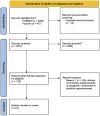The Role of Paternal Involvement on Behavioral Sensitive Responses and Neurobiological Activations in Fathers: A Systematic Review
- PMID: 35355925
- PMCID: PMC8959913
- DOI: 10.3389/fnbeh.2022.820884
The Role of Paternal Involvement on Behavioral Sensitive Responses and Neurobiological Activations in Fathers: A Systematic Review
Abstract
As fathering research has flourished, a growing body of studies has focused on behavioral and neurobiological mechanisms, respectively associated with caregiving sensitivity and responsiveness to infant stimuli. However, the association between these aspects and the key concept of paternal involvement in childcare (i.e., contribution in infant care in terms of time, availability, and responsibility) has been poorly investigated. The current work aims to systematically review the role of involvement in childcare on both neural activations and sensitive behaviors in fathers by examining (a) how paternal involvement has been measured and (b) whether paternal involvement has been associated with neurobiological activation and behavioral sensitive responses. Inclusion criteria were peer-reviewed quantitative studies, concerning fathers responding to infant stimuli at neurobiological or behavioral level, and including a quantitative measurement of paternal involvement in childcare. A quality rating for each study has been performed based on the measurements adopted to assess paternal involvement. Of 2,529 articles, 27 studies were included. According to our quality rating, 10 out of 27 studies included fairly good-standard measures for measuring paternal involvement, whereas 17 studies used good-standard measures. In addition, 11 studies provided details of paternal involvement in the context of neurobiological responses to infant stimuli, whereas 16 addressed paternal sensitive behaviors. Overall, only 8 studies reported relevant findings about the relationship between paternal involvement and neurobiological responses or sensitive behaviors in fathers. The present study is the first systematically evaluating the scope of paternal involvement in the field of Paternal Brain and fathers' sensitive responsiveness research. When high-standard measures are used, paternal involvement seems to play a significant role in modulating both the hormonal and the neural pathways associated with paternal behaviors. Remarkably, the role of paternal engagement may underpin an adaptive nurturance that is not dependent on pregnancy and childbirth but on caregiving experience. A promising positive link between paternal involvement and behavioral sensitivity may be expected in further studies, which will need to corroborate our conclusion by adopting detailed and appropriate measures assessing paternal involvement. As a future line of research, the inclusion of gay fathers may be beneficial for the field.
Keywords: father; fatherhood; neurobiology; parental brain; paternal behavior; paternal involvement; paternal sensitivity.
Copyright © 2022 Giannotti, Gemignani, Rigo, Venuti and De Falco.
Conflict of interest statement
The authors declare that the research was conducted in the absence of any commercial or financial relationships that could be construed as a potential conflict of interest.
Figures

Similar articles
-
Fathers' cortisol and testosterone in the days around infants' births predict later paternal involvement.Horm Behav. 2018 Nov;106:28-34. doi: 10.1016/j.yhbeh.2018.08.011. Epub 2018 Sep 11. Horm Behav. 2018. PMID: 30165061
-
Relationship between paternal psychological distress and involvement in childcare among fathers of preschool-aged children: mediating effect of maternal psychological distress.BMC Pediatr. 2019 Sep 3;19(1):308. doi: 10.1186/s12887-019-1688-z. BMC Pediatr. 2019. PMID: 31481061 Free PMC article.
-
Birth of a Father: Fathering in the First 1,000 Days.Child Dev Perspect. 2019 Dec;13(4):247-253. doi: 10.1111/cdep.12347. Epub 2019 Oct 14. Child Dev Perspect. 2019. PMID: 31894183 Free PMC article.
-
The Paternal Brain in Action: A Review of Human Fathers' fMRI Brain Responses to Child-Related Stimuli.Brain Sci. 2021 Jun 20;11(6):816. doi: 10.3390/brainsci11060816. Brain Sci. 2021. PMID: 34202946 Free PMC article. Review.
-
Fathers' involvement during pregnancy and childbirth: An integrative literature review.Midwifery. 2018 Jul;62:135-145. doi: 10.1016/j.midw.2018.04.013. Epub 2018 Apr 11. Midwifery. 2018. PMID: 29680523 Review.
Cited by
-
Attentional bias to infant faces might be associated with previous care experiences and involvement in childcare in same-sex mothers.Int J Clin Health Psychol. 2024 Jan-Mar;24(1):100419. doi: 10.1016/j.ijchp.2023.100419. Epub 2023 Oct 23. Int J Clin Health Psychol. 2024. PMID: 37885912 Free PMC article.
-
The paternal influence on early childhood development in Africa: implications for child and adolescent mental health.Child Adolesc Psychiatry Ment Health. 2024 Dec 6;18(1):156. doi: 10.1186/s13034-024-00847-4. Child Adolesc Psychiatry Ment Health. 2024. PMID: 39643898 Free PMC article.
-
Neither Parents' Sex Nor the Type of Family Modulates Attentional Bias Toward Infant Faces: A Preliminary Study in Different-Sex and Same-Sex Parents.Arch Sex Behav. 2024 Jun;53(6):2053-2061. doi: 10.1007/s10508-024-02875-9. Epub 2024 May 29. Arch Sex Behav. 2024. PMID: 38811490 Free PMC article.
-
No evidence for relationship between paternal post-partum depressive symptoms and testosterone or cortisol in first-time fathers.Front Psychol. 2024 Feb 15;15:1348031. doi: 10.3389/fpsyg.2024.1348031. eCollection 2024. Front Psychol. 2024. PMID: 38425562 Free PMC article.
-
Attentional Prioritization of Infant Faces in Parents: The Influence of Parents' Experiences of Care.Int J Environ Res Public Health. 2022 Dec 28;20(1):527. doi: 10.3390/ijerph20010527. Int J Environ Res Public Health. 2022. PMID: 36612848 Free PMC article.
References
-
- Ainsworth M. D. S., Blehar M. C., Waters E., Wall S. (1978). Patterns of Attachment: a Psychological Study of the Strange Situation. London: Lawrence Erlbaum.
-
- Aldus J., Mulligan G. M. (2002). Fathers' child care and children's behavior problems. J. Fam. Issues 23, 624–647. 10.1177/0192513X02023005003 - DOI
-
- Amodia-Bidakowska A., Laverty C., Ramchandani P. G. (2020). Father-child play: a systematic review of its frequency, characteristics and potential impact on children's development. Dev. Rev. 57, 100924. 10.1016/j.dr.2020.100924 - DOI
Publication types
LinkOut - more resources
Full Text Sources
Research Materials

